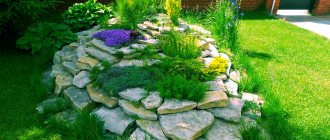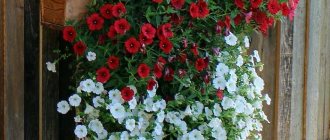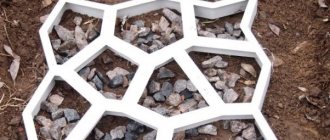Pebbles - smooth round pebbles polished by the sea - are a very popular material for garden decoration today. It looks attractive and aesthetically pleasing both as a material for a garden path or patio, and as a decoration or the main material for a fence. Some owners of private houses pave entire yards with pebbles, creating a strong, durable, beautiful coating. By selecting stones by color, shape, size, and skillfully combining them, you can create amazing patterns. What can you build from pebbles in your garden? Let's look at a few simple examples.
- 2 Example #2 – flower pot trimmed with pebbles
- 3 Example #3 – “pebble” rugs
- 4 Example #4 – a basket of sea stones
- 5 Example #5 – pebble path
5.1 Free-fill path
- 5.2 Path with fixed stones
Building material donated by nature
In ancient times, people used what was at hand to build housing and decorate it: wood, stone, clay, straw. The choice depended on geographical conditions. Those who lived along rivers or the sea coast had access to pebbles. It was impossible to build thick walls with it, but this fine-grained material was perfectly suited for paving roads. It was also used to decorate the façade parts of foundations, fences, fountains and the banks of artificial reservoirs.
Pebbles in landscape design Source pbs.twimg.com
At its core, pebbles are natural stones (rock fragments) that are small in size. They usually have an oblong shape, round or flat (it all depends on the origin of the material). Sea pebbles are smoother than river pebbles, with a mirror-like surface. It is formed in the process of alternating ebbs and flows: salt water in motion can act as an abrasive sharpener.
Multi-colored sea pebbles Source storge.pic2.me
The morphological structure of pebbles is superior to granite, so it is much stronger. Scientists have found that it has bactericidal properties, so it can be considered hygienically clean. During the construction process, pebbles do not enter into chemical reactions with solutions and adhesive mixtures. The material is mined using open-pit mining. Then the pebbles are sold in their original form. Today there are technologies that make it possible to cut pebbles, sharpen them and polish them, so it becomes possible to create very beautiful paths from pebbles in the countryside.
By alternating large and small pebbles, you can create any patterns Source i.pinimg.com
The texture of the material is varied. It has a wide range of colors. There are pebbles in blue, pink, green, white, red and grey. If desired, you can use it to create patterns and carpet designs on the floor and, thereby, significantly increase the decorativeness of the garden and emphasize the style of the chosen landscape design.
Stones of different colors and sizes allow you to create beautiful mosaics Source medias.digitamix.com
The combination of large and small pebbles looks original. It works well with any other finishing materials and easily emphasizes the advantages of wood, metal, and flagstone. The structure of the stone harmoniously combines with the plants planted in the garden and well emphasizes their richness and beauty.
Pebbles and flagstone together look very organic Source i.pinimg.com
See also: Catalog of companies that specialize in landscape design and gardening
A properly laid pebble path in your dacha will last a very long time. It will not crack over time, sea and river fine-grained stone easily withstands heat and cold, it is not afraid of sudden temperature fluctuations, does not fade in the sun, maintaining the beautiful appearance of the garden plot for a long time.
A pebble path will last a very long time Source maja-dacha.ru
Any natural stone accumulates heat well, holds it and releases it slowly. Therefore, it is very pleasant to walk barefoot along such garden paths. This opportunity, according to doctors, has a beneficial effect on human health. Walking on warm stones relaxes, relieves internal tension, and restores good spirits. If small pebbles were used for garden paths, the effectiveness of foot massage increases. The impact on biologically active points responsible for the functioning of internal organs heals. And this is another reason to choose pebbles to form the lining of walking routes inside the dacha.
Walking barefoot along such a path is pleasant and healthy Source www.florentinemasonry.com
Example #4 – a basket of sea stones
To create a decorative pebble basket you will need the following tools: two small plastic pots of the same size, scissors, a sheet of plywood (10 mm thick), a pencil, a jigsaw, transparent film, a hammer, several nails, frost- and moisture-resistant cement glue, small flat pebbles (approx. 200 pieces, length – 3-4 cm), wire cutters, spatula, brush, wire mesh.
So, let's get to work. First, cut off the rim (2.5 cm wide) from the top of one of the pots. We compress the rim so that we get an oval, apply it to a piece of plywood, and trace the outline. Then we cut out the resulting figure on plywood with a jigsaw. The rim is placed on a plywood oval and attached to it with nails along the edges of the plywood. This is a template for creating the base of the basket.
The base is laid out with film, its edges should protrude on the sides. The form is filled with a layer of cement mortar 10-12 mm thick. The wire mesh is adjusted to the size of the mold and pressed into the cement. The basket is a garden decoration, you will probably want to plant some flowers in it, so you need to make holes in the base for drainage.
Cement glue is applied to the flat side of the stones and they are glued to the base. Once you have glued all the stones to the base, leave it to cure overnight. After drying, the plastic rim must be removed and the finished base separated from the plywood. Turn it over and remove the film.
The picture reflects the first 4 stages of work: create a template for the bottom, fill it with cement, use mesh and film and start laying stones
Now let’s start “laying the walls” of the basket. Apply glue to the stones and lay out the first row along the edge of the base. The remaining rows are laid out in exactly the same way, only with greater coverage, otherwise the walls of the basket will not be inclined, but straight.
After you have made five rows of masonry, let the glue dry for half an hour; to be sure, you can prop up doubtful places with a mug. Excess cement should be cleaned off before hardening. To remove, you can use a narrow spatula or a modeling tool, and clean the surface of the stone with a brush.
The base is ready, now let's start creating the “masonry”, to lay out the last row you can use round pebbles, as in this case, or select pointed ones
Then another 2-3 rows of pebbles are laid out, the last row, in order to give the product originality, can be laid out with round pebbles. After finishing the laying, leave the basket to harden for a couple of hours.
Recent Entries
Lilac perennials that are beautiful, compact and do not crowd out other plants Why when buying seedlings you should not take the sellers’ word for it and how to determine the age of the plant using 3 signs Tomato seedlings have turned purple or whitish: why the color has changed and how to save the plants
Now you need to make a handle. We cut a rim from another plastic pot and pass it through the center of the product, the handle should protrude above the top edge of the basket. The handle is laid out with flat stones edgewise; use more mortar to create the handle. Place the stones on both sides at the same time, the last one should be in the middle. Dry the solution and remove any excess. After a few hours, when the solution becomes solid, carefully remove the plastic rim and clean the bottom of the handle.
You can even use trash to decorate your summer cottage. How exactly:
A basket of pebbles will look great on the terrace, at the entrance to the gazebo, or in any other corner of the garden. If you won’t surprise anyone with vases and pots, such a small form will inevitably attract attention
Please note that it is better not to take the basket by the handle - in any case, this part of the product will be the most fragile.
Selection rules
Both sea and river pebbles are suitable for paving paths and areas in the garden. The first has a smooth surface, so it is more difficult to work with. The second one is rougher and flatter. Buying large stones will speed up the process of creating frames for hiking routes, but adding small pebbles will make it possible to create more complex three-dimensional patterns.
Small and large sea pebbles Source yandex.net
What is it suitable for?
A variety of types of pebbles will highlight the style inherent in your summer cottage. If the cottage is decorated in a Mediterranean style, then it will be necessary to lay out various mosaic patterns, highlighting many shades and changing the size of the pebbles. When decorating a site in country style, it would be appropriate to use plain gray raw materials of a small, or better yet, very fine fraction.
These tracks have practical applications
When the house is decorated in high-tech style, you can complement the existing main approaches to housing with thin paths made of small stones, dividing different areas of your garden according to their intended purpose. If there is a pond or alpine hill on the site, large pebbles and paths paved with them will be an excellent completion of the landscape design.
Laying features
The ease of installation of pebble paths is another advantage of choosing a natural material. Anyone who has basic construction skills can carry out paving.
It all starts with digging a trench 30 cm deep. A cushion is built at its bottom - the basis of the future path. To create it, you need to pour a ten-meter layer of sand, compact it, and pour crushed stone on top with a five-centimeter layer.
Trench for the path Source kursk.ridatex.ru
Pebble path care
Caring for Pebble Paths
Despite the fact that stone paths are quite durable structures, they need to be maintained regularly. The main enemy of pebble canvas is plants. Their roots can easily destroy a cement slab. Based on this, it is necessary to promptly cut down bushes and pull out large grass on the sides of the path.
Cement may lose its strength and develop cracks from prolonged exposure to water. To prevent this, you need to treat the canvas with special impregnations twice a year. This will not only protect it from dampness, but also improve its appearance. In addition, the cement will stop dusting and thinning.
If a pebble falls out of the hole for any reason, it can be glued into place using synthetic glue or liquid nails. The crumbled edges of the hole are covered with cement mortar and treated with a deep penetration primer. The broken stone is glued together with thermal glue, the seam is rubbed and painted over. If necessary, you can paint the stone completely.
Briefly about the main thing
Pebbles are an ancient building material. It was previously actively used for paving city streets. In China today there are gardens with pebble paths that are more than a thousand years old. They are a real work of art.
There are two types of pebbles: sea and river. The first has a smoother surface, it has a mirror shine. The second one is more rounded. Both types are superior to granite in strength.
Interest in pebbles is growing today. Summer residents are increasingly using it to create garden paths. This choice allows you to make durable, reliable paths that can last for decades. The installation process is extremely simple. And this is the main advantage of choosing a natural building material.
Ratings 0
The benefits of mulching
Rock mulch inhibits weed growth. Ensures the safety of the root and surface systems of plants from being eaten by pests. Including slugs and rodents, who prefer to use organic filling.
The material maintains soil moisture and temperature. Unpretentious to sunlight, natural precipitation, climate change. Withstands high loads. Its main disadvantage remains the cost. Rock fragments cost the site owner more, along with organic material.
Want to know more? We recommend reading the article about the pros and cons of filling with stones, in comparison with mulching with bark.
Types of Garden Paths
Depending on the stones used and the method of laying, the following paths are distinguished:
- Bulk. Geotextiles are laid in the dug ditch, and screenings, pebbles or gravel are poured on top. Brick borders are made on the sides. For reliability, granite tiles are installed in the center of the path. Fix the material with a layer of sand.
- Jellied. The most reliable type of tracks. Concrete solution is poured into the prepared ditch. Natural stone and paving stones are laid on top. The base can withstand heavy loads, so they are made even near garages.
- Natural. Well-trodden paths. No costs required. A significant drawback is that it is difficult to pass during rainfall. They are quickly washed away by water. A good solution would be to decorate them with river pebbles, cobblestones, and old bricks.
Most owners of country houses choose flooded paths that are not afraid of precipitation. They are durable and resistant to mechanical stress.
Cost of services in companies in Moscow and St. Petersburg
Laying of garden paths can be ordered from specialists. But you should understand that you will have to pay a different price for each stage of work. It all depends on the complexity and labor intensity of the process. The average price list for Moscow and St. Petersburg is as follows:
- site preparation, trench – 120 rub/m3;
- laying geotextiles (cost of material included) – 100 rub/m2;
- drainage (crushed stone layer 10 cm) – 80 rub/m2;
- backfilling sand 10 cm – 70 rub/m2;
- pouring mortar – 200 rub/m2;
- clinker laying – 600 rub/m2;
- granite paving stones – 1200 rub/m2;
- sandstone, flagstone – 600 rub/m2;
- installing a curb - 200 rubles. for 1 linear meter.
In addition, the craftsmen provide a guarantee for the work done. Its duration varies depending on the material used.
Stone paths in a summer cottage are a practical and durable decoration of the area and a universal element of different styles of landscape design.
Pebbles as a decorative element of the garden
If the soil in some areas of the garden looks unattractive, this can be easily corrected with the help of pebbles. This material is simply scattered over the surface of the required area. This solution will serve not only as a decorative covering, but also as mulch for plants.
In addition to the above, pebbles can be used to create unique figures. Painted stones are perfect for decorating a playground or recreation area. Ideas for inspiration can be found on the Internet or from specialized magazines.
You can create a unique landscape design on your site using pebbles. It has a beautiful texture, is easy to use, and durable. And most importantly, this material is universal and suitable for both interior and exterior use.











